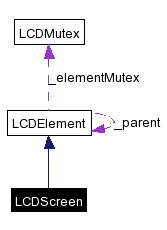
#include "api/LCDScreen.h"
Inheritance diagram for LCDScreen:


Definition at line 16 of file LCDScreen.h.
Public Member Functions | |
| LCDScreen (LCDElement *parent=0, std::string name="", std::string id="") | |
| Default Constructor. | |
| void | setName (std::string name) |
| Change the name of the screen. | |
| void | setWidth (int width) |
| Change the width of the screen. | |
| void | setHeight (int height) |
| Change the height of the screen. | |
| void | setPriority (std::string priority) |
| Change the priority of the screen. | |
| void | setHeartBeat (std::string heartbeat) |
| Enable or disable heart beat. | |
| void | setBackLight (std::string backlight) |
| Enable or disable screen backlight. | |
| void | setDuration (int secondEights) |
| Set the time the screen is displayed during each rotation. | |
| void | setTimeOut (int secondEights) |
| Set the time to live of the screen. | |
| void | setCursor (std::string cursor) |
| Set the cursor state. | |
| void | setCursorPosition (int x, int y) |
| Set the cursor position on screen. | |
| void | setCursorX (int x) |
| Set the x coordinate of the cursor. | |
| void | setCursorY (int y) |
| Set the y coordinate of the cursor. | |
| void | add (LCDElement *child) |
| Add a child to the component. | |
| const std::string & | getId () |
| Returns Id of the element. | |
Static Public Member Functions | |
| bool | exists (std::string id) |
| Test if a widget with given Id exists. | |
|
||||||||||||||||
|
This constructor can be used without parameter in most cases. But the screen will have to be added to a client.
Definition at line 6 of file LCDScreen.cpp. |
|
|
This method is used to add a child to a component.
Definition at line 110 of file LCDElement.cpp. |
|
|
This static method is used to test the existence of a widget.
Definition at line 76 of file LCDElement.cpp. |
|
|
With this method one can have read access to the element identifier.
Definition at line 82 of file LCDElement.cpp. |
|
|
Enable or disable the backlight for the current screen.
Definition at line 55 of file LCDScreen.cpp. |
|
|
Change the way the cursor is displayed.
Definition at line 70 of file LCDScreen.cpp. |
|
||||||||||||
|
Move the cursor to a point specified with its coordinates. They are always 1-based, wich means that top-left is (1,1).
Definition at line 85 of file LCDScreen.cpp. |
|
|
Change only the x coordinate of the cursor position on screen.
Definition at line 75 of file LCDScreen.cpp. |
|
|
Change only the y coordinate of the cursor position on screen.
Definition at line 80 of file LCDScreen.cpp. |
|
|
Change the time the screen will be visible during each rotation.
Definition at line 60 of file LCDScreen.cpp. |
|
|
Enable or disable the heart beat used by LCDproc to show data transmission.
Definition at line 50 of file LCDScreen.cpp. |
|
|
Sets the height of the screen in characters. If unset, the full display size is assumed.
Definition at line 40 of file LCDScreen.cpp. |
|
|
Sets the screen's name as visible to a user.
Definition at line 30 of file LCDScreen.cpp. |
|
|
Sets priority of the screen. Only screens with highest priority at a moment will be shown.
Definition at line 45 of file LCDScreen.cpp. |
|
|
Change the time to live of the screen. After the screen has been visible for a total of this amount of time, it will be deleted
Definition at line 65 of file LCDScreen.cpp. |
|
|
Sets the width of the screen in characters. If unset, the full display size is assumed.
Definition at line 35 of file LCDScreen.cpp. |
 1.3.6
1.3.6